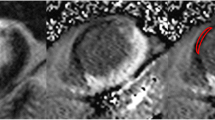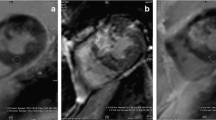Abstract
To compare the image quality of late gadolinium enhancement (LGE) cardiac magnetic resonance imaging (CMR) using a single dose of gadolinium contrast agent versus the conventional double dose for assessing myocardial infarction. This retrospective study examined 37 patients with chronic myocardial infarction who underwent LGE CMR using both inversion recovery (IR)-turbo fast low-angle shot magnitude-reconstructed and phase-sensitive images with two different dosages of gadolinium contrast agent: a single dose of 0.1 mmol/kg gadolinium-DTPA in 17 patients and a double dose of 0.2 mmol/kg in 20 patients. The contrast-to-noise ratio (CNR) and visual conspicuity between infarct and normal myocardium (CNRinfarct-normal, conspicuityinfarct-normal) and between infarct and left ventricular cavity (CNRinfarct-LVC, conspicuityinfarct-LVC) were compared. Interobserver agreement for the maximal transmural extent of infarction was also evaluated. CNRinfarct-normal was significantly higher with double-dose gadolinium contrast agent (15.5 ± 20.7 vs. 40.4 ± 16.1 in magnitude images and 9.5 ± 2.8 vs. 11.2 ± 2.7 in phase-sensitive images, P < 0.001) while conspicuityinfarct-normal showed no significant difference between the two groups (P > 0.05). Both CNRinfarct-LVC (7.7 ± 10.7 vs. −6.6 ± 19.0 in magnitude images and 4.1 ± 2.3 vs. −0.4 ± 4.1 in phase-sensitive images, P < 0.05) and conspicuityinfarct-LVC were significantly better with single-dose gadolinium contrast. Interobserver agreement for assessing the transmural extent of infarction was moderate in both groups: 0.591 for single-dose and 0.472 for double-dose. LGE CMR using a single dose of gadolinium contrast agent showed significantly better contrast between infarcted myocardium and left ventricular cavity lumen without a significant decrease in visual contrast between infarcted myocardium and normal myocardium, compared to a double dose.


Similar content being viewed by others
Abbreviations
- CMR:
-
Cardiac magnetic resonance imaging
- CNR:
-
Contrast-to-noise ratio
- IR:
-
Inversion recovery
- LGE:
-
Late gadolinium enhancement
- LV:
-
Left ventricle
- ROI:
-
Region of interest
- SD:
-
Standard deviation
- SI:
-
Signal intensity
References
Go AS, Mozaffarian D, Roger VL, Benjamin EJ, Berry JD, Borden WB, Bravata DM, Dai S, Ford ES, Fox CS, Franco S, Fullerton HJ, Gillespie C, Hailpern SM, Heit JA, Howard VJ, Huffman MD, Kissela BM, Kittner SJ, Lackland DT, Lichtman JH, Lisabeth LD, Magid D, Marcus GM, Marelli A, Matchar DB, McGuire DK, Mohler ER, Moy CS, Mussolino ME, Nichol G, Paynter NP, Schreiner PJ, Sorlie PD, Stein J, Turan TN, Virani SS, Wong ND, Woo D, Turner MB, American Heart Association Statistics C, Stroke Statistics S (2013) Heart disease and stroke statistics–2013 update: a report from the American Heart Association. Circulation 127(1):e6–e245
Kim RJ, Wu E, Rafael A, Chen EL, Parker MA, Simonetti O, Klocke FJ, Bonow RO, Judd RM (2000) The use of contrast-enhanced magnetic resonance imaging to identify reversible myocardial dysfunction. N Engl J Med 343(20):1445–1453
Kim RJ, Fieno DS, Parrish TB, Harris K, Chen EL, Simonetti O, Bundy J, Finn JP, Klocke FJ, Judd RM (1999) Relationship of MRI delayed contrast enhancement to irreversible injury, infarct age, and contractile function. Circulation 100(19):1992–2002
Fieno DS, Kim RJ, Chen EL, Lomasney JW, Klocke FJ, Judd RM (2000) Contrast-enhanced magnetic resonance imaging of myocardium at risk: distinction between reversible and irreversible injury throughout infarct healing. J Am Coll Cardiol 36(6):1985–1991
Nacif MS, Arai AE, Lima JA, Bluemke DA (2012) Gadolinium-enhanced cardiovascular magnetic resonance: administered dose in relationship to United States Food and Drug Administration (FDA) guidelines. J Cardiovasc Magn Reson 14:18
Kim RJ, Shah DJ, Judd RM (2003) How we perform delayed enhancement imaging. J Cardiovasc Magn Reson 5(3):505–514
Kanal E, Barkovich AJ, Bell C, Borgstede JP, Bradley WG Jr, Froelich JW, Gilk T, Gimbel JR, Gosbee J, Kuhni-Kaminski E, Lester JW Jr, Nyenhuis J, Parag Y, Schaefer DJ, Sebek-Scoumis EA, Weinreb J, Zaremba LA, Wilcox P, Lucey L, Sass N, Safety ACRBRPoM (2007) ACR guidance document for safe MR practices: 2007. AJR Am J Roentgenol 188(6):1447–1474
Abujudeh HH, Kaewlai R, Kagan A, Chibnik LB, Nazarian RM, High WA, Kay J (2009) Nephrogenic systemic fibrosis after gadopentetate dimeglumine exposure: case series of 36 patients. Radiology 253(1):81–89
Wagner A, Mahrholdt H, Thomson L, Hager S, Meinhardt G, Rehwald W, Parker M, Shah D, Sechtem U, Kim RJ, Judd RM (2006) Effects of time, dose, and inversion time for acute myocardial infarct size measurements based on magnetic resonance imaging-delayed contrast enhancement. J Am Coll Cardiol 47(10):2027–2033
Durmus T, Schilling R, Doeblin P, Huppertz A, Hamm B, Taupitz M, Wagner M (2012) Gadobutrol for magnetic resonance imaging of chronic myocardial infarction: intraindividual comparison with gadopentetate dimeglumine. Invest Radiol 47(3):183–188
Petersen SE, Mohrs OK, Horstick G, Oberholzer K, Abegunewardene N, Ruetzel K, Selvanayagam JB, Robson MD, Neubauer S, Thelen M, Meyer J, Kreitner KF (2004) Influence of contrast agent dose and image acquisition timing on the quantitative determination of nonviable myocardial tissue using delayed contrast-enhanced magnetic resonance imaging. J Cardiovasc Magn Reson 6(2):541–548
Fleiss JL (1981) Statistical methods for rates and proportions, 2nd edn. Wiley, New York, NY
Kramer MS, Feinstein AR (1981) Clinical biostatistics. LIV. The biostatistics of concordance. Clin Pharmacol Ther 29(1):111–123
Braunwald E, Rutherford JD (1986) Reversible ischemic left ventricular dysfunction: evidence for the “hibernating myocardium”. J Am Coll Cardiol 8(6):1467–1470
Tillisch J, Brunken R, Marshall R, Schwaiger M, Mandelkern M, Phelps M, Schelbert H (1986) Reversibility of cardiac wall-motion abnormalities predicted by positron tomography. N Engl J Med 314(14):884–888
Perrone-Filardi P, Pace L, Prastaro M, Squame F, Betocchi S, Soricelli A, Piscione F, Indolfi C, Crisci T, Salvatore M, Chiariello M (1996) Assessment of myocardial viability in patients with chronic coronary artery disease. Rest-4-h–24-h 201Tl tomography versus dobutamine echocardiography. Circulation 94(11):2712–2719
Pagley PR, Beller GA, Watson DD, Gimple LW, Ragosta M (1997) Improved outcome after coronary bypass surgery in patients with ischemic cardiomyopathy and residual myocardial viability. Circulation 96(3):793–800
Chaudhry FA, Tauke JT, Alessandrini RS, Vardi G, Parker MA, Bonow RO (1999) Prognostic implications of myocardial contractile reserve in patients with coronary artery disease and left ventricular dysfunction. J Am Coll Cardiol 34(3):730–738
Reimer KA, Lowe JE, Rasmussen MM, Jennings RB (1977) The wavefront phenomenon of ischemic cell death. 1. Myocardial infarct size vs duration of coronary occlusion in dogs. Circulation 56(5):786–794
Hillenbrand HB, Kim RJ, Parker MA, Fieno DS, Judd RM (2000) Early assessment of myocardial salvage by contrast-enhanced magnetic resonance imaging. Circulation 102(14):1678–1683
Kellman P, Arai AE, McVeigh ER, Aletras AH (2002) Phase-sensitive inversion recovery for detecting myocardial infarction using gadolinium-delayed hyperenhancement. Magn Reson Med 47(2):372–383
Ingkanisorn WP, Rhoads KL, Aletras AH, Kellman P, Arai AE (2004) Gadolinium delayed enhancement cardiovascular magnetic resonance correlates with clinical measures of myocardial infarction. J Am Coll Cardiol 43(12):2253–2259
Kim RJ, Albert TS, Wible JH, Elliott MD, Allen JC, Lee JC, Parker M, Napoli A, Judd RM, Gadoversetamide Myocardial Infarction Imaging I (2008) Performance of delayed-enhancement magnetic resonance imaging with gadoversetamide contrast for the detection and assessment of myocardial infarction: an international, multicenter, double-blinded, randomized trial. Circulation 117(5):629–637
Setser RM, Chung YC, Weaver JA, Stillman AE, Simonetti OP, White RD (2005) Effect of inversion time on delayed-enhancement magnetic resonance imaging with and without phase-sensitive reconstruction. J Magn Reson Imaging 21(5):650–655
Simonetti OP, Kim RJ, Fieno DS, Hillenbrand HB, Wu E, Bundy JM, Finn JP, Judd RM (2001) An improved MR imaging technique for the visualization of myocardial infarction. Radiology 218(1):215–223
Gupta A, Lee VS, Chung YC, Babb JS, Simonetti OP (2004) Myocardial infarction: optimization of inversion times at delayed contrast-enhanced MR imaging. Radiology 233(3):921–926
Huber AM, Schoenberg SO, Hayes C, Spannagl B, Engelmann MG, Franz WM, Reiser MF (2005) Phase-sensitive inversion-recovery MR imaging in the detection of myocardial infarction. Radiology 237(3):854–860
Huber A, Schoenberg SO, Spannagl B, Rieber J, Erhard I, Klauss V, Reiser MF (2006) Single-shot inversion recovery TrueFISP for assessment of myocardial infarction. AJR Am J Roentgenol 186(3):627–633
Acknowledgments
This study was supported by a grant from the SNUH Research Fund (No. 04-2012-0820).
Conflict of interest
None.
Author information
Authors and Affiliations
Corresponding author
Rights and permissions
About this article
Cite this article
Kim, Y.K., Park, EA., Lee, W. et al. Late gadolinium enhancement magnetic resonance imaging for the assessment of myocardial infarction: comparison of image quality between single and double doses of contrast agents. Int J Cardiovasc Imaging 30 (Suppl 2), 129–135 (2014). https://doi.org/10.1007/s10554-014-0505-x
Received:
Accepted:
Published:
Issue Date:
DOI: https://doi.org/10.1007/s10554-014-0505-x




